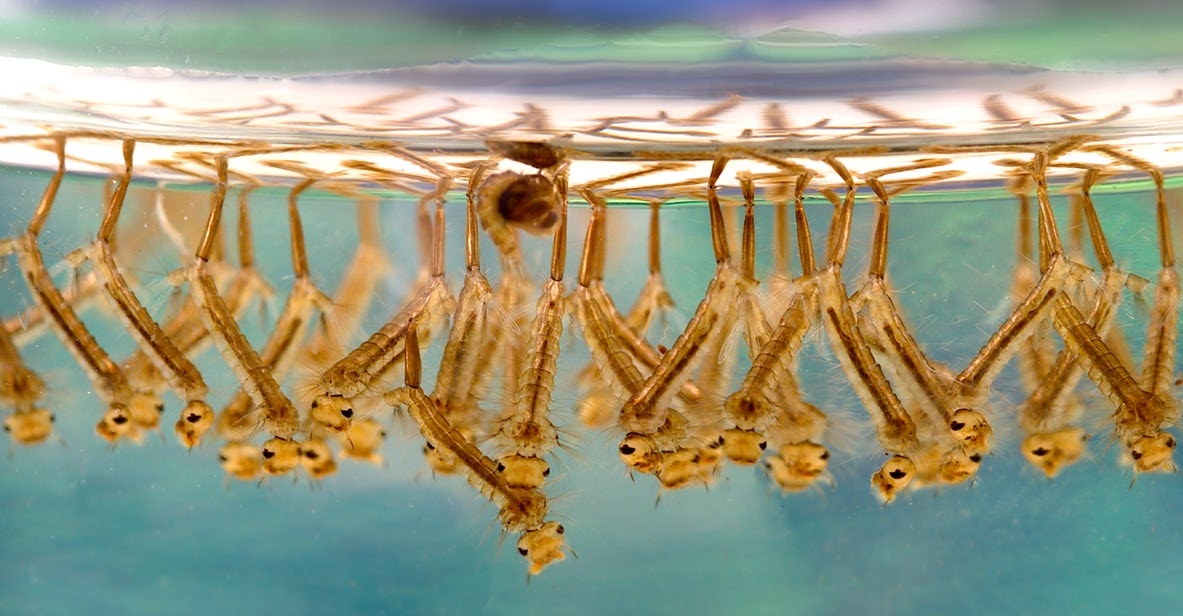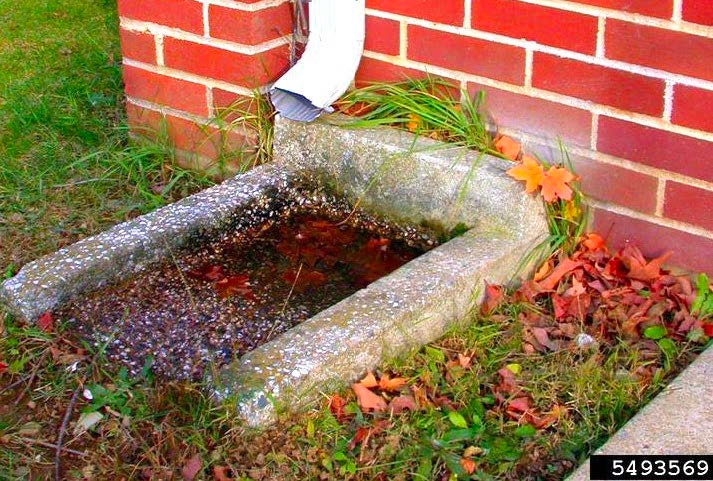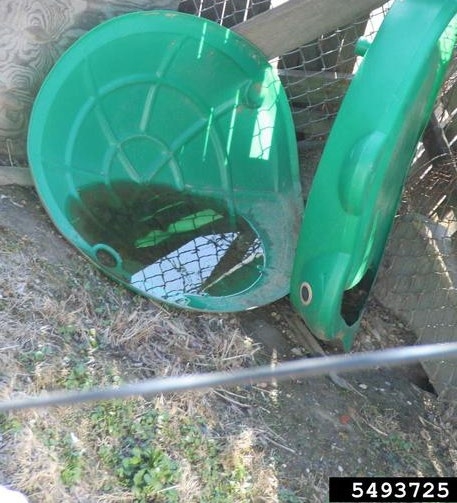Mosquitos and their Control
ID
ENTO-202NP (ENTO-470NP)
Introduction
Mosquitoes (Fig. 1) occur throughout Virginia and are both nuisance pests and potential carriers of disease. Knowledge of their habits and basic control measures can reduce their threat and annoyance.

Control
The key to controlling mosquitoes is removing the standing or stagnant water where they live. Follow these suggestions.
For Residences or Businesses
- Empty any water-filled containers neardwellings and outbuildings each week.Mosquitoes can also breed in tarps or awningsthat catch water.
- Remove or recycle any containers that holdwater.
- If you plan to keep containers that hold water,place a cover over them and make sure thatcover itself will not hold water.
- Check gutters to make sure they drain properlyand do not hold water.
- Flush and refill the water in birdbaths weekly.
- Place goldfish in water gardens to eat mosquitolarvae. Can also use mosquito “donuts” or other products that release Bt israelensis in water.
- Use tight-fitting lids on rain barrels, or add Btisraelensis products to the barrel.
- Use expanding foam to fill any tree holes thathold water.
- Check roofs for standing water.
- Properly discard old tires (Fig. 2).
- Drain ditches or low-lying areas that hold water.
- Report unusually high numbers of mosquitoes toyour local Health Department.

Figure 2. Remove tires that collect standing water (Liz Kasameyer, John Hopkins School of Public Health, Bugwood.org).
Personal Protection for Yourself:
- Long sleeves, long pants, socks, and closed toeshoes offer protection from mosquito bites
- Use products that contain DEET, picaridin, or oil of lemon eucalyptus on exposed skin but not under clothing. Follow all instructions on the label.
- Check and repair window and door screens.
Description
Most common mosquitoes are brown or black with tan or white lines or markings (Fig. 1). All adult pest mosquitoes have long mouthparts that are used to pierce skin and feed on blood. In addition, adult mosquitoes have three pairs of long, slender legs and a pair of narrow wings. They measure 6-13 mm (0.25-0.5 inch) long. Only the adult females feed on blood, which they need to produce their eggs; adult males feed on nectar.
Immature mosquitoes are worm-like and called wrigglers because of the way they thrash around in water. They are also 6-13 mm (0.25-0.5 inch) long. Mosquito pupae are called tumblers for the way they somersault through the water. Both wrigglers and tumblers breathe air, usually through breathing tubes at the water’s surface (Fig. 3)
Immature mosquitoes are worm-like and called wrigglers because of the way they thrash around in water. They are also 6-13 mm (0.25-0.5 inch) long. Mosquito pupae are called tumblers for the way they somersault through the water. Both wrigglers and tumblers breathe air, usually through breathing tubes at the water’s surface (Fig. 3).

Figure 3. Mosquito larvae surround a single mosquito pupa at the water’s surface (James Gathany, CDC, CC BY 2.5).
Habitat
Mosquito larvae live in non-moving, still water often with some organic matter in it (Figs. 4 & 5). They like cans, buckets, gutters, water gardens, birdbaths, kiddie pools, tree holes, puddles, open rain barrels, flower pots, cemetery vases, animal water dishes, and sheets of plastic on the ground that hold water (Figs. 4). Shallow water is more attractive than deep water, and even small containers that hold only several ounces of water are prime breeding habitats for mosquitoes. Excess rain in the spring will provide plenty of breeding places for mosquitoes. Mosquitoes do not survive in water sources that support fish or beneficial aquatic life, which quickly eat the mosquito larvae. They are not found in streams, rivers, ponds or fast-moving water.

Figure 4. Standing water provides breeding sites for mosquitoes (Liz Kasameyer, John Hopkins School of Public Health, Bugwood.org).

Figure 5. Children’s outdoor play toys frequently collect water and should be emptied weekly (Liz Kasameyer, John Hopkins School of Public Health, Bugwood.org).
Life Cycle
Adult female mosquitoes seek a blood meal for each batch of eggs they produce. Male mosquitoes do not bite or feed on blood. Eggs are laid on or near standing water and larvae must have water to develop. Larvae feed on bits of organic matter in the water, becoming full-grown in about one week under warm conditions. The pupal stage lasts two to three days. Most mosquitoes require warm weather to complete their life cycle and are not found during extended cold weather. Most adults remain close to the site where they developed.
Common Mosquito Species
- Asian tiger mosquito (Aedes albopictus, Fig. 1),is a day-biting nuisance mosquito common inurban areas of Virginia and a possible carrier ofdengue, West Nile virus, chikungunya, LaCrosse encephalitis, Eastern equineencephalomyelitis, St. Louis encephalitis, andZika virus.
- Asian rock pool mosquito (also known as Asianbush mosquito, Aedes japonicus) is a possiblecarrier of dengue, West Nile virus, chikungunya,La Crosse encephalitis, Eastern equineencephalomyelitis, St. Louis encephalitis, andZika virus.
- Yellow fever mosquito (Aedes aegypti) is asubtropical mosquito found in some locations inVirginia and is a possible carrier of dengue andchikungunya.
- Banded spring mosquito (Aedes canadensis), is anuisance biting mosquito.
- Eastern treehole mosquito (Aedes triseriatus)breeds in water-holding containers near housesand is a possible carrier of La Crosseencephalitis.
- Flood-water mosquito (Aedes tivittatus) is anuisance biting mosquito.
- Vexans mosquito (Aedes vexans) is a nuisancebiting mosquito.
- Northern house mosquito (Culex pipiens) is anuisance biting mosquito and a possible carrierof St. Louis encephalitis.
Note
Lights with electrocution devices known as “bug zappers” kill very few mosquitoes but many insects that are not pests. Ultrasonic devices marketed as being able to repel mosquitoes have not worked as claimed in scientific trials.
Revised
Theresa A. Dellinger, November 19, 2021.
Virginia Cooperative Extension materials are available for public use, reprint, or citation without further permission, provided the use includes credit to the author and to Virginia Cooperative Extension, Virginia Tech, and Virginia State University.
Virginia Cooperative Extension is a partnership of Virginia Tech, Virginia State University, the U.S. Department of Agriculture (USDA), and local governments, and is an equal opportunity employer. For the full non-discrimination statement, please visit ext.vt.edu/accessibility.
Publication Date
December 21, 2021



